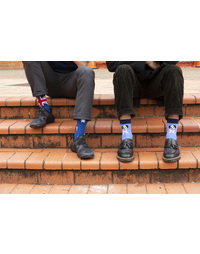Oh my aching feet!

I cannot emphasize enough the importance of having the correct work footwear! Footwear provides cushioning, support and stability and aids in reducing the accumulative load day-to-day at work. There are so many different types of footwear available, and price points, that selecting the right one can be difficult.
Although pain often motivates people to change their behaviour, it’s important to start practicing good foot care habits before discomfort begins.
One common mistake that leads to pain is improper shoe sizing. When shoes are slightly too large, the foot can slip forward in the shoe and the toes may curl to hold it in place. When shoes are too small, the toes can overlap, which increases the risk of calluses. Toes need to spread out to facilitate proper balance1.
Even though runners feel comfortable, nurses need to buy shoes made for walking and standing rather than running. The running step is a very different motion than walking or standing. Running shoes are designed with a higher heel that propels someone forward, but a forward pitch puts nurses off balance for hours at a time. Running shoes also are designed to last between 640 and 800 kilometers, which means many nurses would need to replace them after only seven to nine weeks4. Instead, I recommend that nurses use shoes with heavier soles that can absorb the impact of walking on concrete for many miles each week, like our range at eNurse.
One common condition nurses experience is plantar fasciitis, or inflammation of the thick band of tissue that connects the heel bone to the toes2. A tell-tale sign of plantar fasciitis is stabbing pain in the heel with the first few steps in the morning, and the pain may return after long periods on the feet. The discomfort is usually the result of pressure placed on the plantar fascia, and wearing arch supports for four to six weeks can often remedy the problem — as long as nurses wear them at all times except in bed or in the shower.
Podiatrists also can provide orthotics that are specifically designed for an individual’s foot. Three dimensional scanners can create precise images that help podiatrists create personalised orthotics.
Swelling in the feet and legs is another common consequence of working on the feet all day, and knee-high compression socks are a simple solution to this problem3. Class I socks that are 15-20 mmHG are recommended for people who work on their feet for long hours. Higher levels of pressure may be uncomfortable and lower levels than class I, may not prevent swelling.
Although spending time and money on proper foot care may seem like a low priority compared to other daily demands, neglecting this part of the body is a mistake. If you experience knee pain, hip pain or back pain, it can all stem from your gait and style of shoe. Without the correct alignment and support, all the joints are pushed slightly out of alignment and with the number of steps you take in a day, it takes it toll on any part that isn’t sitting in alignment.
We learn to take care of our eyes, our teeth, our hypertension, but we rarely take care of our feet until something serious develops. Making more of an effort with our foot care, can help alleviate pain that we have become accustomed to living with daily.
References
- https://healthtimes.com.au/hub/nursing-careers/6/news/hw/happy-feet-foot-care-for-nurses-and-midwives/3792/
- https://www.profeetpodiatry.com.au/2018/03/are-you-a-nurse-do-you-suffer-from-sore-feet-rosie-torquay-geelong-podiatrist-gives-her-top-3-tips-to-reduce-pain
- https://www.nursebuff.com/nurses-feet-pain/
- https://www.nurse.com/blog/2018/10/08/the-right-nursing-shoes-and-proper-foot-care-go-hand-in-hand/
There arenÕt many professions more taxing on the feet than that of a nurse or midwife. Long shifts, concrete floors and the demands of the job can take a significant toll. Painful conditions become chronic quickly, and once these issues get to that stage, they become costlier to fix and may require surgery or pain-relieving injections.




